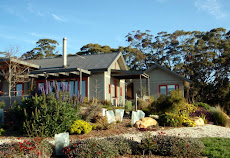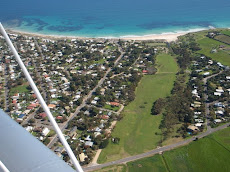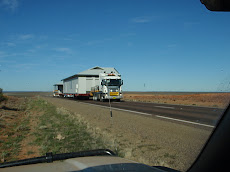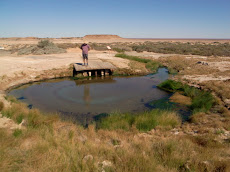We are sitting in the dark with the hiss and yellow light cast by the spirit lamp, warming the air beside us. There is that softness so helpful for arthritic joints, and there are many of those around us here in the (rather lovely) caravan park at Jabiru. This really is a club. Members are jolly mostly, always ready to be helpful, and certainly happy to have a chat for just as long as you’ve got. That mix of now quite familiar faces with the addition, now we’re in the international travel spot of Kakadu, of many young European things having a “get to know you” experience in their Britz vans. Fritz 'n Britz.
Last night we sat here and wondered at the unmistakable cry of a very young crocodile somewhere in the park behind us (we’ve both watched enough Attenborough to remember that), and pondered on the whereabouts of its mother! The receptionist assured us it must have been a Butcher bird imitating a young crocodile. Oh yes, at 11pm? Every walk we go on is now preceded by 1.5x1m signs explaining what a rather silly idea moving anywhere in this place is, unless in thick armour. The howling of dingoes on most evenings is music by comparison.
We were in Alice when we last posted, having the suspension fixed up. We spent that day at the Alice Springs Desert Park. If any of you are there even for a short time, it is worth experiencing what the desert can be like after a good drenching. Alice had not received any rain for over a year, so drip irrigation was essential to show the full glory of the flowers and trees, and the songs of the amazing birds that feast on them. This is a very good place, well laid out and with informative displays that are sensitively managed. The Nocturnal House is not to be missed, being the only way you will see our dwindling (thanks largely to feral cats) native wildlife. Quolls, Bilbies, Dunnarts, Spinifex Hopping Mice, and some wondrous lizards and snakes.
News flashed around the caravan park the morning we left. There were people at Ti Tree a hundred klicks up the road, taking fresh fruit and veges off folk as they entered the mango growing area up there. “Par boil your spuds, peel the onions” was the call. H called the info number who confirmed that this was indeed the case, as they were worried about the fruit fly disease risk (so many Victorians). As the spuds were boiling another champion who had actually visited the info centre said “turn them off – it’s not compulsory”. Parboiled spuds are OK for a couple of days travelling in a damp plastic bag, but after that, phew! These are the challenges
There is little reason, once north of Alice, not to put the figurative foot down, and start to burn up the miles, because there is a long way to travel. The countryside is broad and scrubby with distant ranges, for hour upon hour. It becomes mesmerising and is not boring, but a little tedious (H disagrees - never finds it tedious). As a southerner used to people around it is extraordinary, this complete absence of housing, workshops, anywhere within sight. Occasional “towns” set aside from the main road, cannot be by-passed because of a need to make some sort of contact with people, even if the excuse is a Weiss bar. This is the land around Barrow Creek, where poor Mr Falconio met his end (we have just had lunch in Darwin with a colleague of H’s, who was at the local pub when his girlfriend was taken there, all scratched and bruised, after that dreadful event).
Entering these places is about confronting the, in some cases, appalling poverty endured by the aboriginal people there. Places like Aileron. A wheelless Holden smoulders under a tree, with a dense blanket of smoke overpowering the nostrils. A dozen or so people hanging around the roadhouse, their only source of community, or so it would seem. Dereliction is everywhere really. But against that, the children are playing gleefully in the dust in a way that is almost forgotten to us now, who have become so obsessed with cleanliness and appearance. But still I think we’ve dealt these people a very poor hand.
With these experiences fresh in mind, we approached Tennant Creek with a little trepidation, caused mainly by the inflammatory remarks of the manager of the mango farm at Ti Tree (their mango ice cream is worth the side trip for). Tennant Creek – where a native land claim crafted by the local mob took 19 years to bring about due largely to the resistance of the NT government of the time. Tennant Creek, where the traditional owners of the land were once banned from entering the town perimeter, and who now walk the streets with perhaps a greater sense of purpose (the financial counsellor colleague of Helen’s at Anglicare here in Darwin assures us we were wearing rosy glasses at the time).The Nyinkke Nyungu aboriginal culture centre had good displays by local people documenting their history, the land rights struggle, local art, and artefacts retrieved from various museums. The old telegraph station outside Tennant Creek was a slice of white settlement history.
A special breakfast stop after a free camp beside the road at Taylors Well was the Devil’s Marbles outside Wauchope. Wonderful piles of granite in all sorts of configurations.
At 23degS we crossed into the tropics and from about 18degS the vegetation began changing from scrub to woodland. Up on the Barkly Tableland the Spinifex grasses gave way to savannah woodland with more grasses, and the termite mounds became larger, the air softer. A night at Daly Waters pub caravan park was a good introduction to the tropics, followed by the thermal pools at Mataranka where we took an early morning bathe followed by another of H’s botanical walks. This is We of the Never Never country, co
Nitmiluk NP (Katherine Gorge) follows, where you have to settle down for some serious gorge cruising shared with many others. Descriptions of this place in the wet are amazing, with 11 and occasionally 18 metres of water rushing through this gorge in that season, enough for crocodiles to be found in the fresh fish section of Woolworths, in Katherine (third largest town), some miles downstream. Katherine Gorge is in fact a series of about 13 gorges, of which the lower three are readily accessible by way of a change of boat at the start of each. In the first is Jedda’s rock where for those who remember the film she plunged to her death. The guide explained more extraordinary geology, and the uses indigenous people made of various plants. At the head we took a short climb into a large swimming hole with waterfall – the Lily Pond. The escarpment above is marked by very old rock art in ochre dealing with women’s birthing business. These are once secret places where the women took their young girls and gave them instruction in the changes they faced as puberty came, and the does and don’ts they would need to deal with adulthood.
Further north the next day and after Pine Creek, we turned right and headed into Kakadu. As the sun was heading down we went off the main road for 40kms, to Gunlom on Waterfall Creek. This place was fantastic – no other word for it. It’s a really low key place to camp but with good facilities and a charming local couple acting as gatekeepers. After receiving assurances that the parks and local people had done much work to make sure there were no saltwater crocodiles in the area after the flooding of the wet season, we took off straight away for a lone swim in the 100m diameter plunge pool at the bottom of the 200 m high water fall. The following day we climbed to the top of the falls, onto the plateau, where this lovely creek carved its way through a series of pools and short rapids, before reaching three deepish and perfect swimming holes, then plunging over the edge to the valley floor below. We arrived after the tour bus left, so peace and the attraction of Merten’s water monitors and other wild life made th
Kakadu for the first timer does surprise because for the most part it is nothing like the tourist brochures. It is very large at 20,000 sq.kms, and in the dry season looks largely woodland. It is mostly the catchment area that then feeds the wetlands below, through deeply incised cracks in the sedimentary rock. All of this land is subject to patch burning at this time of year, to limit fire risk at the end of the dry season in a few months time. There is a lot of smoke, familiar to country Victorians particularly! As you drive closer to the main rivers, being the East and South Alligator Rivers especially, you experience the great expanse of flood plain that is 4 metres under, in a wet year. The abundance of everything is plain to see, and Kakadu is apparently the only place in Australia where there have been no extinctions of local species. Mostly there are numerous spots where you approach billabongs and creeks through patch burnt woodland, looking rather scruffy as a consequence. There is a certain surreal quality as you steel yourself to advance through the bushes to spy some quite deep gully, with grey brown muddy sides steep enough you hope to at least slow the progress of an advancing large reptile.
Then you discover Kakadu’s two main attractions, a wetlands cruise on Yellow Water, and the rock art at Nourlangie Rock, and Ubirr, which is 40 kms from Jabiru and the Ranger uranium mine. We were on the water for a couple of hours before sunset and were able to see many, many birds in their proper place. A fish eagle guarding his nest, father jacanas with fluffball babies, jabiru/black necked storks, herons, 6 different sorts of egrets, submarining darters, magpie geese, ducks, and the ever present whistling kites... there are approx. 240 species of birds in Kakadu. Everyone of course wants to see a crocodile, and we did, but really the action is with the landscape itself. Landscape less affected by the hand of mankind than most areas, though water buffalo used to foul even this place until the RAMSAR treaty was adopted and signed in the 1980’s. The buffalo are mostly gone but feral pigs (and they are big!) and brumbies remain. RAMSAR protects wetlands both here and in those countries where the birds migrate to in Indonesia and Asia. Places where wetlands are being drained at such a frightening rate that in some cases numbers are seriously threatened. The only shock after the cruise was serious attack by heat seeking missiles in the Cooinda camp ground. The mozzies meant very early bed after a hasty meal of baked beans washed down with a bottle of something cold and white.

















































































































2 comments:
Dear Helen and Ian,
I'm enjoying traveling with you in my imagination, thanks for sharing your trip with us, love Sue Lindsay
Lovely reading, and giving me much vicarious pleasure.
DD
Post a Comment